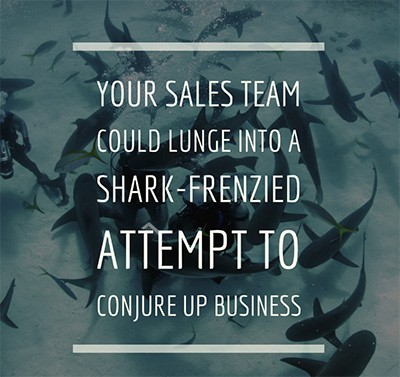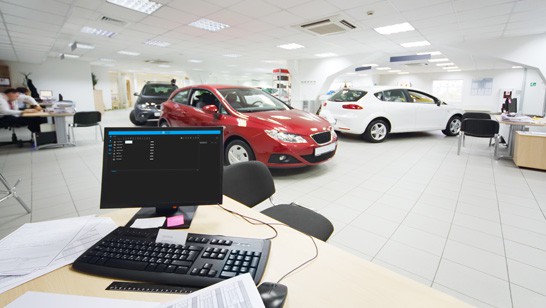Six sales reps stand outside the showroom doors. Two smoke cigarettes and gaze off into space. The third kicks the ground to pass the time. The rest are checking Facebook on their phones. Every manager knows some variation of this scene. What they don’t realize is how much money it costs them. But it doesn’t have to be this way. Here are five ways a closed floor is more efficient and profitable than the traditional open floor.
1. Culture
We all remember the good old days – it was like shooting fish in a barrel. Those days are gone, and they aren’t coming back. We all realized this, cried in our scotch for a bit, and began trundling into the 21st century by embracing price transparency, SEO, CRMs, reputation management, and social media.
Shoppers are spending more time shopping online (about 12.5 hours) and visiting fewer dealerships (1.6 according to McKinsey) than in years past. It’s time to align our dealership’s culture with the new way people shop for cars.
The name of the new game is;
a. Providing (all the) information your customers want in a user-friendly way
b. Following up and establishing trust
c. Setting appointments
d. Treating people well
Closing your floor fosters a culture where these four vital activities will flourish. Your sales team is no longer a pack of wild dogs scavenging for their next meal. They’re professionals, set up to provide customers with the shopping experience they want and deserve. Culture matters. Your customers can sense it in the air.
How many opportunities are you missing?
Find Out! Click below to calculate how many opportunities your sales team is throwing away.
2. Increased Control & Accountability
Do you believe your sales team should be solely responsible for qualifying customers?
Of course not – but if you’re utilizing an open floor strategy, this is exactly what’s happening. They could be doing it right now, as you read this – you don’t know. It’s the same reason why some green peas do so well. Because they haven’t learned to qualify yet, they treat everyone with the same open and attentive attitude. We’ve seen this enough times to know it ‘s true. It’s not beginner’s luck; it’s beginner’s lack of pre-judgment.
Like lions in the Serengeti scanning the herd of gazelle, your experienced salespeople size up the customer the moment they step out of their vehicle. The inner dialogue goes something like this: “10-year-old Corolla. Probably paid off. Got the wife with him, both decision makers present, nice. He’s got dirty work boots – means he’s probably got a job. Let’s go!” Now, compare that inner dialogue with, “Ugh – motorcycle up…neck tattoo. I never sell motorcycle ups. Gotta go. Bathroom time.”

The motorcycle man, who is ready and able to buy that day, gets treated like a second-class citizen. Meanwhile, hours are wasted on that “nice couple” who has no money down and a combined 800 FICO score because they decided last month was a good time to stop paying all their bills.
The inherent beauty of a closed floor retail strategy is that it forces your sales staff to treat each customer like the rare and sacred opportunity they are. Or, in the melodic words of Stephen Stills, “If you can’t be with the one you love, love the one you’re with.”
3. Information = $$
What percentage of customers make it into your CRM?
For reasons we just discussed, open floor strategies are conducive to skewing that number toward the low end. Sure, you could chalk this up as the “cost of doing business.” But something even more expensive and sinister is afoot…
Imagine this: Salesman “Tom” greets 8 walk-in customers, burns through five, and only 3 end up in your CRM. If he closes 2, his closing ratio would appear to be 66%. Great job TOM!
But, what about those five missing customers? In reality, Rockstar Tom is closing at 20%.
It’s simple math. If you are not getting ALL traffic in the CRM, you CANNOT accurately track your marketing ROI. Tom’s five unaccounted for opportunities leave you with the false impression that your marketing efforts only brought in three customers.
So what do you do? Naturally, you ramp up advertising to bring in more customers. Closed floor plans end this vicious loop of inaccurate data and allow you to capitalize fully on your marketing expenditures.
Modern shoppers are using a multi-channeled approach to pinpoint their next vehicle. Missing information means you don’t understand exactly how people are finding your dealership. This is equivalent to taking your marketing budget to the high-stakes craps table.
4. Increased Productivity
Imagine your dealership as a football field. What determines your bottom line is the who and the how – the people that play there and how they perform. Now imagine each and every player on that team is paid based solely on how many touchdowns they make. Even the kicker. You see where this is going…
A closed floor model allows your sales team to achieve an  optimum balance between working on the leads in their CRM queue and assisting fresh floor traffic. It takes away the harrowing stress sales professionals feel when they aren’t actively hunting for their paycheck. Instead of loitering like lot vultures, they now have time to focus on these leads and follow-ups. Additionally, it empowers them with the presence of mind to treat these potential buyers with the level of personalized attention that translates into sales.
optimum balance between working on the leads in their CRM queue and assisting fresh floor traffic. It takes away the harrowing stress sales professionals feel when they aren’t actively hunting for their paycheck. Instead of loitering like lot vultures, they now have time to focus on these leads and follow-ups. Additionally, it empowers them with the presence of mind to treat these potential buyers with the level of personalized attention that translates into sales.
Last but not least, they can do it in a systematic and orderly fashion. Alternatively, your sales team could wait until the last week of the month and then lunge into a shark-frenzied attempt to conjure up business. If aliens visited an open floor dealership, they would form the notion that human beings like to shop for vehicles by being left mostly alone the first three weeks of every month and then bombarded for the last few days.
Your team will perform to their highest potential under an up rotation model because you’ve set them up for success by dis-incentivizing their natural tendency to misappropriate their time. In other words, they can quit staring at the goal line and start getting into formation to run plays.
5. Accurate Performance Metrics
Your consistent 20+ car/month performers – are they rock stars or are they just better at qualifying the traffic?
A common concern of switching to a closed floor model is that you’ll hurt the alpha performers. That seems logical – until you think about it. If I asked you, “Do your customers determine the level of charisma, product knowledge, and sales skills that your top performer brings to the table?” I hope you’d look at me and say, “No, that’s absurd.”
 If a closed floor system did impact their productivity, we could safely deduce that their prowess was not so much their ability to serve your customers, but rather to cherry pick. Alternatively, if one of your wallflowers starts to shine it suggests that individual wasn’t lacking in sales ability, but rather, opportunities.
If a closed floor system did impact their productivity, we could safely deduce that their prowess was not so much their ability to serve your customers, but rather to cherry pick. Alternatively, if one of your wallflowers starts to shine it suggests that individual wasn’t lacking in sales ability, but rather, opportunities.
Will your prima donna top performers complain? Yes, they will. Will some of them have to eat a slice of humble pie? Yes, assure them it’s delicious.
Simply put, egos don’t pay bills. Results do. The ability to accurately track these results in real time is essential to the success of your dealership.
The industry’s new mantra, “evolve or die” dictates you’re only as good as your ability to make strategic, data-driven decisions. We end with an acronym borrowed from statistics and computer science, GIGO = Garbage in, Garbage out. Game changing shakeups are on the horizon as new technologies, such as autonomous vehicles, and social changes, like shared ownership, enter the mix. Whatever you do, don’t use garbage to chart your course. The first step away from the dumpster is a closed floor.




